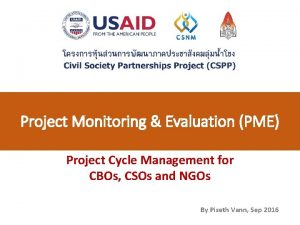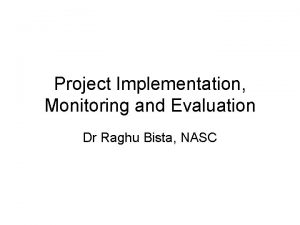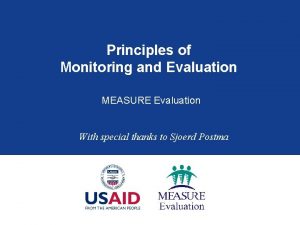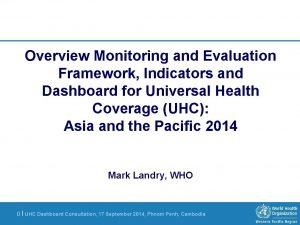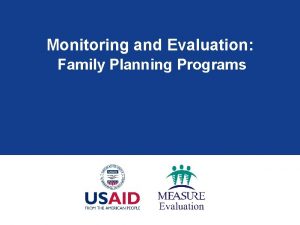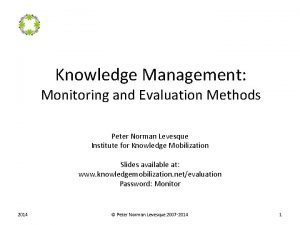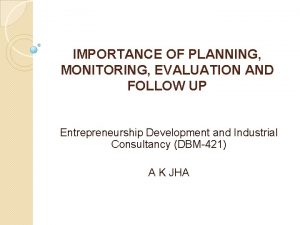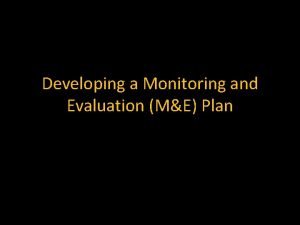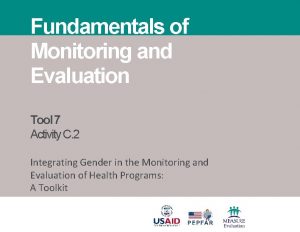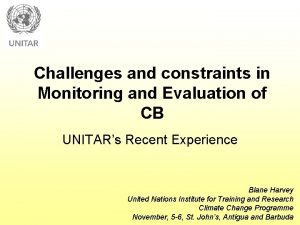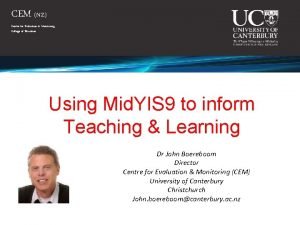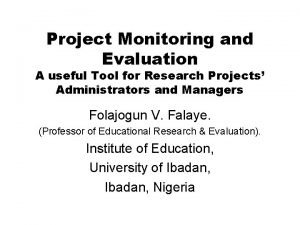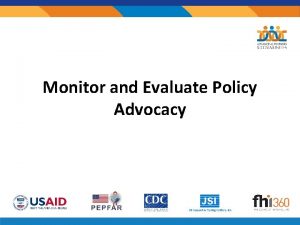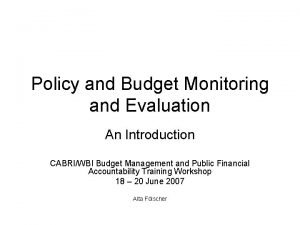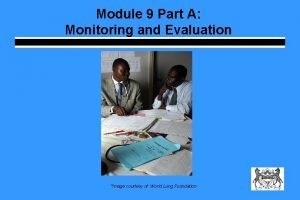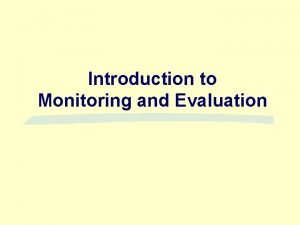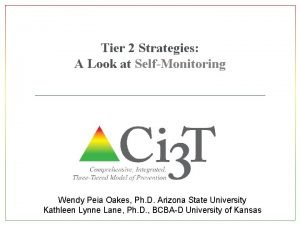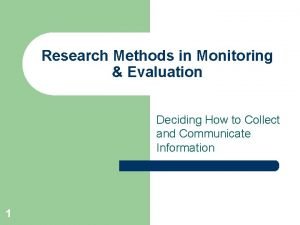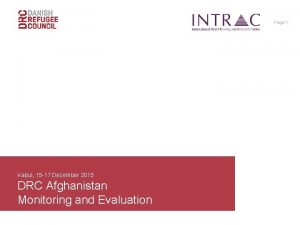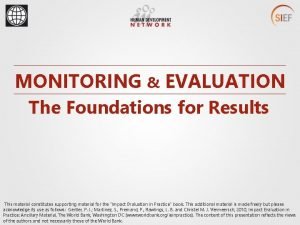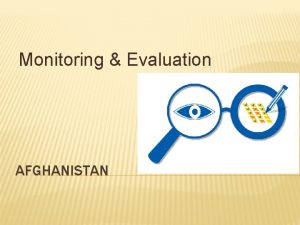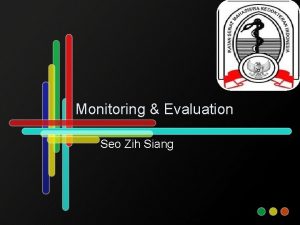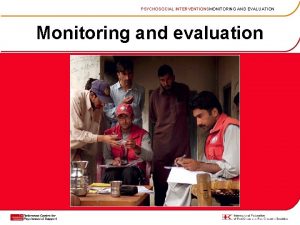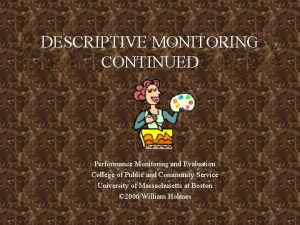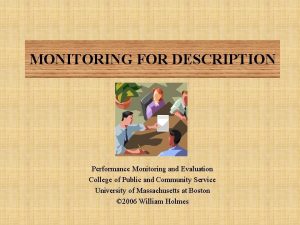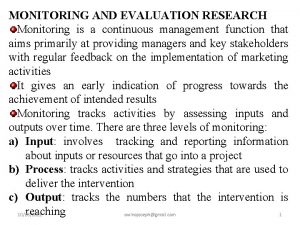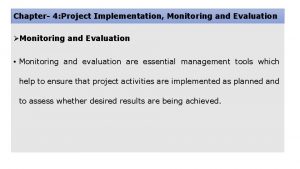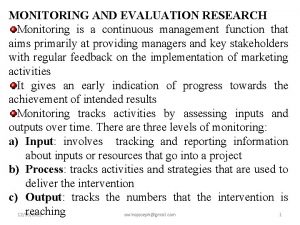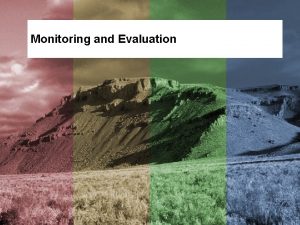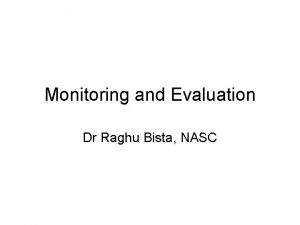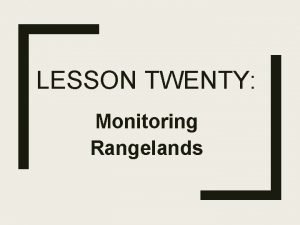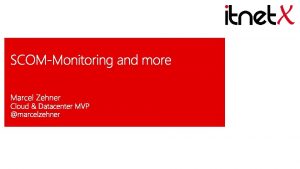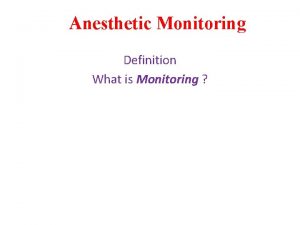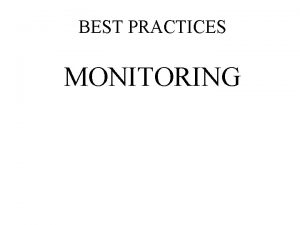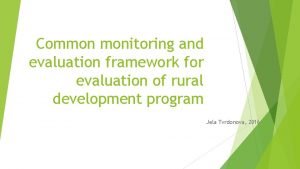Session 8 Monitoring and Evaluation ME 1 Session





















- Slides: 21

Session 8 Monitoring and Evaluation (M&E) 1

Session Objective • Devise a simple monitoring plan for a PHE activity or project 2

Monitoring & Evaluation • PHE projects complex • Different timeframes • Need to demonstrate impact • Contribute to data in field 3

Monitoring & Evaluation • M&E also builds greater transparency and accountability in use of project resources • Information generated through M&E provide project staff with a clearer basis for decisionmaking • Future project planning and development is improved when guided by lessons learned from project experience 4

Relationship Between M&E • M & E are two different management tools that are closely related, interactive and mutually supportive • Through routine tracking of project progress, monitoring can provide quantitative and qualitative data useful for designing and implementing project evaluation exercises • Through the results of periodic evaluations, monitoring tools and strategies can be refined and further developed 5

Comparison Between M&E Item Monitoring Evaluation Frequency Regular, ongoing Episodic Main action Keeping track/oversight Assessment Basic purpose Improving efficiency Adjusting work plan Improve effectiveness, impact, future programming Focus Inputs/outputs, process outcomes, work plans Effectiveness, relevance, efficiency, impact, sustainability Information sources Routine systems, field visits, stakeholder meetings, output reports, rapid assessments Same plus Surveys (pre-post project) Special studies Undertaken by Project/program managers Community workers Supervisors Community (beneficiaries) Funders Other Stakeholders External evaluators Community (beneficiaries) Project/program managers Supervisors Funders Adapted from UNICEF, A UNICEF Guide for Monitoring and Evaluation: Making a Difference? New York, 1991, p. 3 6

Commonalities of M&E • Both monitoring and evaluation must be planned at the program/ project level • Baseline data and appropriate indicators of performance and results must be established 7

Monitoring • In practice, covers a wide range of activities and requires data collection, but data collection is not synonymous with monitoring • Monitoring also implies analysis and use of the data • Generally, the level that records information should be able to use it • Designing data collection systems with this principle in mind helps improve chances that the data will be collected carefully and put to use. 8

Planning a Monitoring System 1. What should be monitored? – Keep information requirements to a bare minimum – Collect info that will be most helpful to those who will use it 2. How? – Select methods to track indicators/report on progress • • Observations, interviews, routine reporting, sentinel sites Piggyback on existing data collection systems Both formal/informal and quantitative/qualitative methods Decide how information will be recorded systematically and reported clearly • Consider the time and skills of those who will collect the data • Pretest new monitoring instruments 9

Planning a Monitoring System 3. Who should be involved when? – Clearly identifying who will collect information on indicators, when (frequency) and who will receive it – The monitoring plan should also identify who will be involved in reviewing progress and providing feedback 4. What resources are needed and available? – The human and financial cost of gathering, reporting and reviewing data should be identified – Needed funding and time should be set aside for this work 10

Planning a Monitoring System 5. Consultation and Training – Discuss the monitoring program with a representative group from each level before it is put into effect – Provide training to those who will be using the monitoring systems 6. Prepare a workplan – for each year – listing the main activities to be carried out, their output, timing and parties involved 11

Example : IPOPCORM Monitoring Purpose: • Serve as the basis for establishing the project’s information systems • Generate information that will allow project managers to: – track achievement of project outputs (immediate results of project activities) , and – monitor progress towards achievement of objectives and desired outcomes (interim results created by outputs) 12

Table 1. Plan to monitor achievement of IPOPCORM outputs (immediate results of project activities) Component Output Policy Planning and Monitoring Indicator Responsible Agency/Person (WHO) No. of Municipal CRM Plan with RH strategies approved by local governments Municipal Planning and Development Offices Annual LGU partner 1. % of barangays with functioning MPA management committees Barangay council record + NGO Output report Quarterly NGO Supervisor Training Reports Semiannually PATH Foundation Trainer Semi. Annually PATH Foundation Trainer Quarterly NGO Supervisor NGO Outreach Worker (for all indicators) 1. 2. Training 3. 1. 2. 3. 1. Integrated IEC Frequency (WHEN) 1. Management Services Means of Collection (HOW) 2. 3. No. of NGO personnel trained in PHE integration/outreach service delivery Change in knowledge on PHE and RH/FP and CRM among trained NGO personnel No. education sessions delivered to fisherfolk on alternative livelihood Pre-post training test scores/Training Reports NGO output report No. of people’s organizations with CBD outlet No. FP clients served by CBDs, by method Net Peso value of socially marketed products NGO output report Quarterly CBD service statistics Monthly No. of linked RH-CRM messages and materials created No. of PHE campaign events delivered in the community during fiesta periods Audience reaction to PHE campaigns and linked RH-CRM messages NGO output report and portfolio of IEC materials Quarterly NGO Outreach Worker NGO output reports Quarterly NGO Outreach Worker FGD Annually 13 NGO Supervisor

Table 2. Plan to monitor progress toward IPOPCORM objectives and desired outcomes Objective 1: Improve reproductive health outcomes among people living in coastal communities 1. Contraceptive prevalence among WRA Objective 2: Enhance management of marine and coastal resources at the community level Objective 3: Increase public and policymakers’ awareness and support for PHE Means of Collection Indicator Frequency Responsible Agency/Person Behavior Monitoring Survey (BMS) Every 24 mo. NGO Supervisor FGD Every 24 mo. Outreach Workers (OW) 3. % of youth who used any method of contraception during first sex BMS Every 24 mo. NGO Supervisor Biophysical Indicators: 1. percent live coral coverage 2. hectares of mangrove coverage Management Indicators 1. No. and size (km 2) of Marine Protected Areas (MPA) under improved management 2. No. of MPA management committees (MMC) established and active 3. No. of fish wardens deputized/active in surveillance and enforcement work 4. No. of validated infractions reported MPA monitoring survey (for both biophysical Annually Peoples Organization (MPA management unit) Municipal Coastal Database (MCD) Annually LGU partner NGO output report Quarterly NGO Outreach Worker MMC logbook Quarterly NGO Outreach Worker 1. Number of policymakers knowledgeable about the inter-relationships between Population and Environment and Food security Policy makers’ survey Annual NGO Project Director 2. Total value of resources leveraged from local governments and communities for implementation of PHE activities Audit of NGO’s financial records and statements Every 24 mo. PATH Foundation Philippines auditor 2. Correct knowledge about emergency contraception (EC) among WRA 14

TASK • Draft a monitoring plan for your project • Make sure that it is tied to your – – – Conceptual Model Results Chain Factors Objectives Indicators Interventions/Activities • Use the Worksheet entitled “PHE Monitoring Plan Tool” (see next slide) Time: 60 minutes 15

PHE Monitoring Plan Tool Objective Intervention / Results Chain Factor Indicator Target (Projected Result by EOP) Means of Collection Frequency Responsible Party 16

How to Use the Tool 1 st Column – insert your pre-determined time-bound objective 2 nd Column – insert your pre-determined Intervention and the associated Result Chain Factor 3 rd Column – list 2 or more of the indicators you selected for the specific intervention-results chain factor set. Try to include an outcome indicator as well as process indicators. 4 th Column - insert a performance target for each indicator – e. g. quantitative estimate of expected result by EOP 5 th Column – insert the Means (HOW) you will gather the information 6 th Column – insert the Frequency of data collection (WHEN) 7 th Column – Insert the name of the party/agency/person who will be primarily responsible for collecting/ reporting the information 17

Sample Worksheet – Sectoral Intervention Objective Intervention / Results Chain Factor Indicator Target (Projected Result by EOP) Means of Collection Frequency Responsible Party Improved RH outcomes among people living in coastal areas by 2004 Establish CBD outlets and services No. of CBD points established Increase from 0 in 2001 to at least 500 by 2004 NGO output reports Quarterly NGO Outreach workers RCF#1 Increase FP access No. FP clients served by CBDs Increase from 0 in 2001 to at least 8000 by 2004 CBD records and sales data Monthly NGO Outreach workers RCF#2 Increase FP method use among women or reproductive age (WRA) and sexually active youth CPR among WRA Increase from 20% in 2001 to 35% by 2004 Behavior Monitoring Survey (BMS) Annually NGO Supervisor and Outreach Workers % of youth (15 -24) who used any contraceptive method during first sex Increase from 5% in 2001 to 20% by 2004 BMS Annually NGO Supervisor and Outreach Workers 18

Sample Worksheet – Integrated IEC Intervention Objective Intervention/ Results Chain Factor Indicator Target (Projected Result by EOP) Means of Collection Frequency Responsible Party Increase awareness among policy makers and the general public about linkages between population, environment and consumption dynamics and food security outcomes in coastal Philippines IEC and advocacy targeting local policymakers and the general public with messages about PHE linkages and CRMFP approaches # Municipal Mayors reached with policy advocacy communication messages 50 Municipal Mayors by EOP Minutes of convergence meetings Annually PHE Field Supervisor # of Municipal CRM plans that include FP activities and budget allocations 25 plans by EOP Municipal CRM plans + NGO output report Annually PHE Field Supervisor # of PHE public education campaigns conducted 20 by EOP NGO output report Annually PHE Outreach Worker # villages that develop and implement linked CRM-FP action plans & activities 100 villages by EOP Village Development Plans Annually PHE Outreach Worker RCF#1 Increase support for integration of FP into CRM policies/agendas at the local level RCF #2 Increase public awareness and involvement in CRM-FP activities NGO output report 19

Sample Worksheet - Value-Added Intervention Objective Community capacitated to manage forest resources in sustainable fashion Intervention/ Results Chain Factor Responsible Target (Projected Result by EOP) Means of Collection Frequency # of ICS units installed 100 ICS/yr @ 4 yrs=400 ICS units by EOP NGO service statistics Every six months PHE Field Supervisor RCF#1 Reduce consumption of firewood Amount of Firewood saved Yr 1=100 mt saved Yr 2=100+100 Yr 3=100+100 Yr 4=100+100+100 Total =1000 mt saved Standard calculation 1 ICS = saves 1 metric tons of firewood/yr Every six months PHE Field Supervisor RCF#2 Reduce time spent on firewood collection RCF #3 Reduce vulnerability to violence among women/girls who gather firewood Average # hours/day spent Decreasing trend Household survey Annually CFUG Chief Decreasing trend Police record; CFUG record Annually PHE Field Supervisor Promote ICS Indicator Party collecting wood # of violations reported by women/girls while Collecting firewood 20

Sample Worksheet – Linked Intervention Objective Community capacitated to implement linked coastal resource management and family planning (CRM-FP) strategies and action Intervention/ Results Chain Factor Indicator Capacity building for CRM-FP at the sub-village level implementation RCF#1 Increase FP practice among PO members RCF#2 Increase PO involvement in CRM RCF#3 Improve food security at the household level Responsible Target (Projected Result by EOP) Means of Collection Frequency # Peoples Organizations trained in both CRM and FP service delivery 50 Peoples Organizations by EOP NGO report & informant interviews with village captains Annually PHE Field Supervisor % of couples currently using FP methods 50% of couples by EOP Survey among POs Annually PO executive committee 5 fish sanctuaries (10 hectares each) established and comanaged by PO by EOP Municipal Database on MPAs Annually PHE Field Supervisor Household survey At least 3 survey rounds conducted every 18 mo. PATH Foundation M&E Officer and PHE Field Supervisor No. and area of MPAs established By POs % of survey respondents who say their family sometimes lacks for food Reducing trend Party 21
 Picme2.0
Picme2.0 Project monitoring cycle
Project monitoring cycle Comparison between monitoring and evaluation
Comparison between monitoring and evaluation Principles of monitoring
Principles of monitoring M&e dashboard
M&e dashboard Monitoring and evaluation of family planning programs
Monitoring and evaluation of family planning programs Knowledge management monitoring and evaluation
Knowledge management monitoring and evaluation Importance of planning, monitoring and evaluation
Importance of planning, monitoring and evaluation Me planning
Me planning Principles of monitoring and evaluation
Principles of monitoring and evaluation Basics of monitoring and evaluation
Basics of monitoring and evaluation Constraints in monitoring and evaluation
Constraints in monitoring and evaluation Centre for evaluation and monitoring
Centre for evaluation and monitoring Difference between supervision monitoring and evaluation
Difference between supervision monitoring and evaluation Monitoring and evaluation in advocacy
Monitoring and evaluation in advocacy Budget monitoring and evaluation
Budget monitoring and evaluation Monitoring and evaluation image
Monitoring and evaluation image Introduction to monitoring and evaluation
Introduction to monitoring and evaluation Monitoring and evaluation tool sample deped
Monitoring and evaluation tool sample deped Research methods in monitoring and evaluation
Research methods in monitoring and evaluation Example of monitoring and evaluation in project proposal
Example of monitoring and evaluation in project proposal Difference between monitoring and evaluation
Difference between monitoring and evaluation

